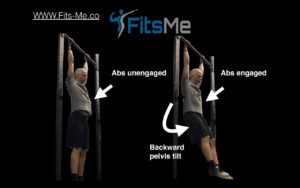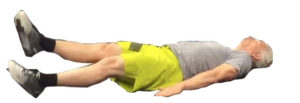One of the absolute biggest benefits of calisthenics training is that most exercises are compound exercises — meaning they involve more than one muscle group.
In contrast to the classical weightlifting in a gym where machines often are used to isolate a specific muscle group, calisthenics exercises are meant to develop your complete body, and thereby also the abs.
Actually, it is very hard to point at a calisthenics exercise where the abs are not involved.
However, in this article we will look at how to put together a calisthenics abs workout with respect to your current level. I will also try to pinpoint the best exercises for your abs and how to progress towards the harder exercises like the Dragon-flag and L-sit.
Before we start, lets just briefly cover the facts about visible abs, as some of you might read this article with that goal in mind.
In order for something to be visible, two things need to be in place:
-
It has to be big enough so you can see it.
-
It shouldn’t be hidden by something.
The first bullet we will take care of in this article. You will not only get one calisthenics abs workout but three — going from beginner to advanced. So that will make your abs big and strong for a long time ahead.
For bullet number two, you need to put your efforts another place… yes, you are right, in the kitchen.
Visible abs for guys starts around a body fat percent of 15-18% and for girls around 19-22% — however, it of course depends how big your abs are.
Therefore you need to bring your body fat percentage down if your are looking for visible abs. And the best option for doing that is to manage your diet. If you want to know more about how to do that, please have a look at my “six-pack diet” article.
Now back to what you came for — the calisthenics abs workout.
As always, lets just identify the muscles we are talking about when we are talking abs or abdominals as they are called.
Some people like to split the abs into upper and lower abs, as well as pointing out the obliques, which are the muscles on the side. From a calisthenics point of view, I don’t think it’s so interesting to focus on exercises that target the upper and the lower abs. The reason for that is that if we do our exercises with full range of motion, we will hit both. For the obliques we need to twist a little bit more to really activate them, but more about that below.
Our calisthenics abs workout will consist of both dynamic and static exercises.
As the main function of your abs is to stabilise your core, the static exercises are important, but we also want to work with the abs in their full range of motion, and therefore we have dynamic exercises as well.
What to be aware of with the dynamic exercises is that they will often involve a lot of hip flexors and psoas, therefore its important to focus on tilting your pelvis forward at some point in the movement to get focus on the abs. This also goes for static moments.
Please see the photo for illustration on pelvis tilt.
The exercises for a calisthenics abs workout
Sit-ups
Yes, good old sit-ups are still working if we do them correctly and don’t overdo them. 300 sit-ups a day won’t do much magic.
The biggest issues with sit-ups is that people are training their hip-flexor instead of their abs. One way to avoid this is to tuck you legs in a butterfly position, and if you have an ab-mat it’s even better. The ab-mat will avoid you from flattening your back out on your way up, and thereby firing the psoas, which can course lower back pain.
Crunches are somewhere in between a good and bad abs exercise. The good thing is that that you actually hit the abs, and the bad thing is that you don’t do a full range of motion. Therefore, I leave them out of the calisthenics abs workout.
Plank
It’s a classic core exercise which also means it will be a good choice for the abs. Just like sit-ups, I would select this exercise for the beginners and I would utilise three types of plank.
Front plank is the normal plank as we know it. Remember to tilt your pelvis and suck your belly-button in.
In Site plank we will be resting on one arm which will target the obliques more than the traditional plank.
Plank with knee to elbow is also targeting the obliques. From a push-up position, we simply bring the right knee to left elbow and the other way around. Try to keep the knee as close to the body as possible.
Flutter kicks
That would be next step and will give you a small taste of the hardest exercise, the dragon-flag.
The closer the feet are to the ground the harder the exercise is. When you can hold it +45sec you have passed the beginner level.
Sitting Jack knifes
Sitting Jack knifes are closely related to Flutter Kicks but have a different angle in the hip. Also we have more motion in the sitting jack knifes.
Inch worm
Inch worm is closely related to the ab wheel exercises but a bit easier. With an engaged core and your pelvis tilted forward, walk your hands out as far as possible and then back again.
Hollow holds
We stay on the ground. Hollow hold is much more than an abs exercises — it’s really tough core exercise.
Hollow rocks should be applied when you can do a good hollow hold for +30sec and not before that.
Leg raises/toes to bar
Knee raises would actually be first step. As the name says, we simply hang on the bar and raises our knees as high as possible. However it’s extremely important to tilt our pelvis either in the beginning in the end to really engage the abs and not just the hip-flexors. When we can do +25 where we go higher than parallel we should move on.
Leg raises are a hard next step, but they will really work your abs. With straight legs, simply raise them above parallel and as high as possible. The tilted pelvis also applies here. +10 would be a good target before we go to next level.
Strict toes to bar should be done slowly and without kipping or swinging. So with straight legs, simply raise them until your toes touch the bar and then slowly lover them again.
Hanging windshield wipers
Now we are focusing a bit more on the obliques so we need some sort of twist. Basically it’s a toes to bar, but just doing it to the sides.
Hanging windshield wipers with tucked knees will make the exercise easier, so start here if the real one is to hard.
L-sit

Here, we are on the ground again and now working on parallettes.
As with the hanging exercises, there will be arm and shoulder strength involved as well.
Tucked L-sit is done by tucking one or both legs in. This will make the exercise easier.
L-sit is performed with straight legs and pointing the toes in a L position, then holding the position for as long as possible.
Dragon-flag

Probably the hardest exercise of them all. Again we need some help from the arms as well as the glutes, but the abs will for sure have to do their part.
Tucked dragon-flag is a good place to start, just like with the L-sit. So, start with both legs tucked in and then try to have one leg fully extended and the other tucked. Alternate the legs and play with the distance to the ground as well — the closer to the floor the harder.
Progression
Those were the exercises that can be used for a calisthenics abs workout — of course there are others, and as mentioned in the beginning, most exercises will work the abs and core. But before we put them together in the three workouts that I promised you, lets just talk about progression.
First you want to make sure that you start out correctly. Meaning that you select a level which you can handle with good form. This is to avoid early fatigue or even injuries. Remember that it’s not important what you accomplish in 3 weeks, but where you are in 1 year from now. A good beginning is half the battle.
I already touched upon some ways to scale the more difficult exercises and when to move to the next level.
Also the speed of which you perform the exercises can be used for progression. Lets take the example of toes to bars. The slower you are able to perform the exercise with full range of motion, the harder it will be.
Finally we have the isometric exercises like L-sit – here we just stay longer in the position.
Calisthenics abs workout
Now for the workouts: As mentioned, there will be three of them and the levels will be beginner, intermediate, and advanced.
Do the workouts 2-3 times a week or just a single time if you already do a full-body workout routine.
Select the version of the exercise that you can handle and move on when the goal has been achieved.
Beginner calisthenics abs workout
We focus on basic exercises to build a good strong foundation.
The idea is not that you should be able to do everything easily in the beginning, and you might need short breaks in between.
A total of 4 rounds — rest 1min between exercises and 2min between rounds.
Round 1 & 3:
-
15 Sit-ups (Butterfly style and ab-mat if available)
-
15+15 Plank with knee to elbow
-
30sec Flutter kicks
Round 2 & 4:
-
Max Plank hold
-
Max Left-site plank hold
-
Max Right-site plank hold
When you can do all rounds without breaks and hold the front plank for more than 90sec in both rounds, it’s time to move on.
Intermediate calisthenics abs workout
We will keep some of the good basic abs exercises but also add some more advanced ones.
For the advanced exercises it’s important that you select a version you can handle and then progress slowly.
A total of 5 rounds — rest 1min between exercises and 2min between rounds.
Round 1 & 3:
-
5 Inch worm — walk the hands out as far as possible but don’t overdo it.
-
20+20 Plank with knee to elbow
-
30sec Sitting Jack Knifes
Round 2 & 4:
-
Max Hollow hold
-
Max Left-site plank hold
-
Max Right-site plank hold
Round 5
-
10 Toes to bar (Start with 25 knee raises, then +10 leg raises and finally toes to bar)
When you can do Hollow hold for 45sec and 10 strict toes to bar, then move on to advanced.
Advanced calisthenics abs workout
As we now have a strong foundation and also nailed some more difficult exercises, it’s time to go for the big ones.
A total of 6 rounds — rest 1min between exercises and 2min between rounds.
Round 1 & 4:
-
10 Toes to bar
-
45sec Hollow Rocks
-
10 Windshield wipers (Progress with tucked knees if needed)
Round 2 & 5:
-
Max L-sit (Progress by tucking both legs, then one)
-
45sec Flutter Kicks
Round 3 & 6
-
7 Dragon-flags (Progress slowly with tucked legs)

